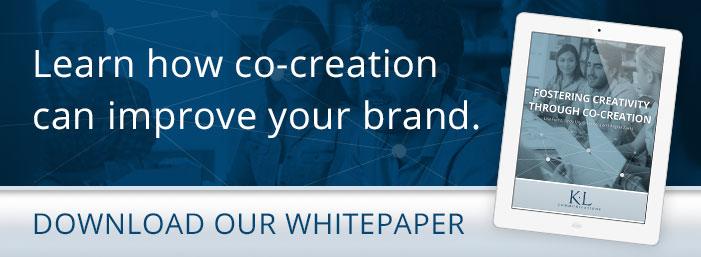
Being selective about which market research tools to apply – when and why – can confer competitive advantage and help increase the distance between you and your competition. The best way to create products and services that are successful is to forge a proactive, collaborative relationship with customers – both those who you target and those whose trust you have earned. Utilizing approaches and tools that are qualitative in nature allows companies to have conversations with their customers which provides deeper insights plus forges a deeper bond.
How to Forge a Collaborative Relationship with Customers
Some of these approaches include bilateral communication, which requires that you listen more than you talk. What is communicated must be clear and affirmed with understanding. Be interesting. Be engaging. Don’t flat-line with a monotone as you check off the questions but be genuinely interested in what customers have to say, not just about your product, but about their business and/or personal goals and the things that they have on their minds. Everyone likes to talk about themselves: both sides need to be given the chance to do so to allow for the establishment of a foundation based on mutual understanding.
Engaging with customers differently and more deeply than you engage with “everybody else” enables companies to build that sense of exclusivity which drives loyalty. Moreover, doing so unleashes the passion that your “customer champions” have for your brand. If the market research tools are applied in the right manner, research efforts will create and/or strengthen a collaborative relationship with customers. Once that collaborative relationship is established, the door is open to an even deeper engagement that can advance, stepwise, through co-creation all the way to design thinking. Beyond that, a collaborative relationship established early in the process often leads to proactivity and likely even future evangelism for your product.
However, you can’t simply jump through the steps. One of the most commonly overlooked steps in market research is the opportunity to forge stronger ties through education. You are the marketer – you understand the subject. But it is unlikely that your customer understands. Explain the process, highlight key aspects of each step and routinely remind the customer where you are in the process. This helps set expectations and subtly queues up the customer to prepare him/her that more time will be required to advance through the remaining steps.
What is Design Thinking? How It’s Used Market Research Tool
Design Thinking has been in practice for over a decade already, yet many still don’t know what it is, nor do they apply it in their business practices. Design Thinking aims to do one thing: create a customer-centric approach to business processes and products. Design Thinking utilizes elements from the designer’s toolkit to arrive at innovative solutions. To yield informative insights, ethnography (studying customers in their natural environment) and empathy (taking a “walk in their shoes”) can help provide a foundational level of understanding of the customer, needs and behaviors which then catalyzes a Design Thinking initiative. Decisions are hence made based on what future customers want from your business versus designing strategies that rely on a retrospective analysis of historical data. By taking a market research approach, decisions can be made based on evidence versus an unsubstantiated risky bet.
Design Thinking is not an easy concept for many to grasp. The two foundational components are empathy and definition (of your customer’s needs, problems and how your insights are aligned conveys your level of understanding to the customer). A collaborative relationship with customers, achieved by engaging with them to understand their needs and clearly defining the needs together, will serve as a platform to advance to the subsequent aspects of Design Thinking: ideation, prototyping and testing. Both ideation and prototyping are routinely done internally with stakeholders based on the insights gathered from the data captured on the customer experience. From there, the Design Thinking process loop is closed by returning to the customers to test, evaluate and validate the prototype concept.
We at KL Communications, have fully embraced Design Thinking to the point that we have integrated it into our co-creation philosophy. and incorporate the customer into all aspects of the process. We conduct exploratory sessions to define the problem and need but often involve the customer in both the ideation and prototyping phase. Via co-creation, KL Communications’ clients benefit by being able to reap the seeds of inspiration directly from the customers for immediate and direct application to the product design.
Companies, such as Apple®, Samsung® and others are particularly adept at directly harvesting inspiration from customers. How? These companies have embraced the art and science of Design Thinking. Customers are particularly challenged by the question or even the idea of imaging life in a future state using products that don’t yet exist so engaging with customers throughout the market research process is especially important for revolutionary products.
We believe that co-creation, and, specifically, our CrowdWeaving® methodology, puts customers in the driver’s seat. It’s the perfect complement to Design Thinking as it encourages collaboration, iteration and “tail-gating” so that customers can build upon each other’s ideas to both enhance and refine them. In 2018, KL Communications received a 2018 Design Thinking Certificate from Rutgers Center for Innovation Education.
Market Research Tools
With customers online all the time, there is a tremendous opportunity for companies to engage and connect with them on all levels, via a multitude of market research tools. Surveys are highly useful but market research tools that let you collaborate – and even co-create – with your customers bring an added dimension of insight. They also go a long way towards establishing a deeper connection, which builds loyalty. There are a number of tools available and can be used together to not only get a complete understanding of customer behaviors, wants and needs, but to allow companies to truly collaborate with customers.
Some of these tools include but are not limited to:
- Discussion Boards: Companies can evaluate how much latitude they want to give to their customers and can offer anything from free-form to strict policing. The value of this market research tool is that it affords customers with an opportunity to build other customers’ ideas and definitions ultimately driving consensus.
- Online Focus Groups & Journaling: This market research tool allows customers to engage when they’re ready via a format with which that they are comfortable. Journaling is something that they can do on their own time in the privacy of their own homes and can feel more relaxed sharing their thoughts in this forum. Online focus groups can offer the same intimacy or open the floodgates. Businesses like SideHustle, FlexMR, Centiment and numerous others have sprung up offering to pay people for their opinions via participation in online focus groups.
- Closed Question Surveys: Asking closed questions limits the potential for insights from a market research effort but does afford researchers with a more quantifiable approach to validating concepts. A market research effort that is both qualitative and quantitative will help ensure an accurate and comprehensive understanding of the customer, needs and expectations.
- Ideation Sessions: Mashing up concepts and people with different backgrounds and perspectives corralled in around a defined set of stimulating questions will spark deep discussion and ideas. Tools like Imaginatik™ offer a collaborative market research tool that tracks ideas and votes to help identify and prioritize the best ideas.
- Collaborative Concept Tests: An innovative combination technology and tool is Mondopad™, which enables real-time engagement and collaboration. This market research tool is best applied in-person through co-creation. Hands-on workshops allow customers to both see and feel the concept, which overcomes the barrier that most customers have when they try to imagine something that doesn’t exist and how they would interact with that new product. Prototypes literally bring insights and learning to life.
- CrowdWeaving® Challenges: This proprietary market research tool enables companies to reframe the problem statement based on customer input and helps elicit a refined value proposition. By engaging customers early in the design process, captured insights can be integrated into the process from the beginning. Doing so drives stronger engagement and affords market research companies with the opportunity to apply a variety of methods to synthesize, analyze, iterate and refine the ideas throughout the process.
Market research tools are more abundant than ever before. It’s important to embrace a combination of established market research tools together with innovative new ones.
